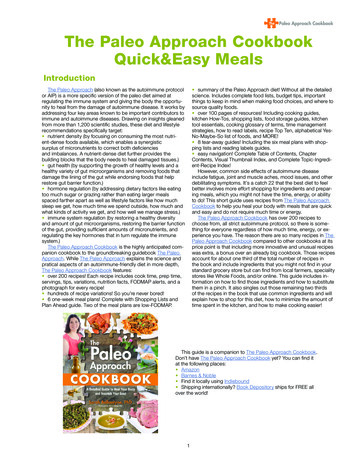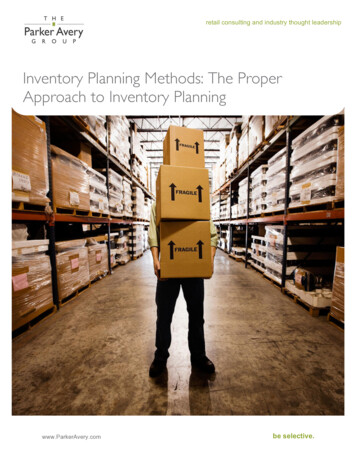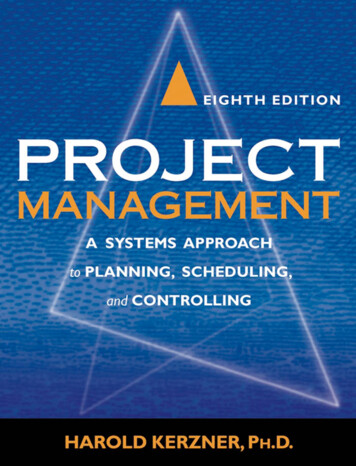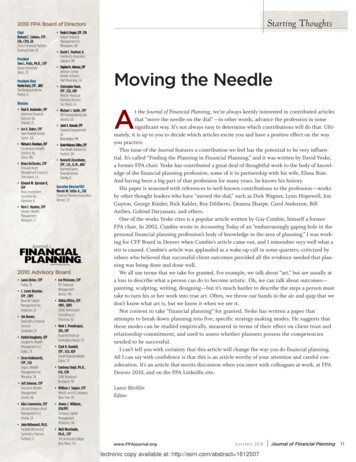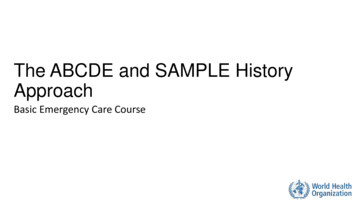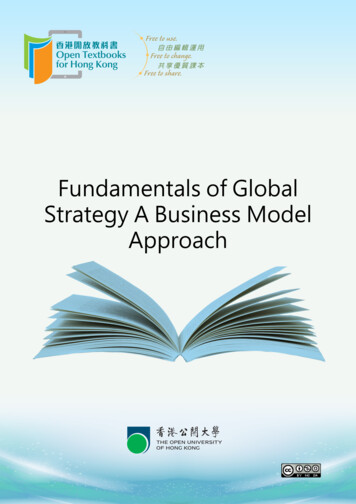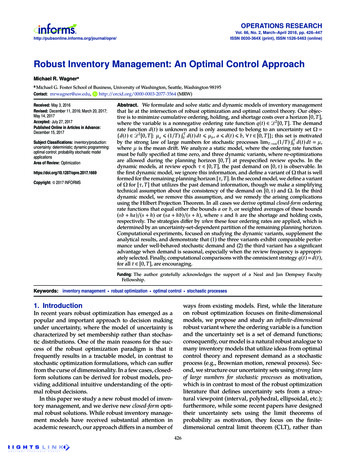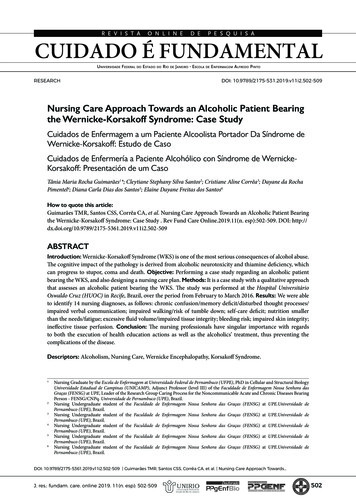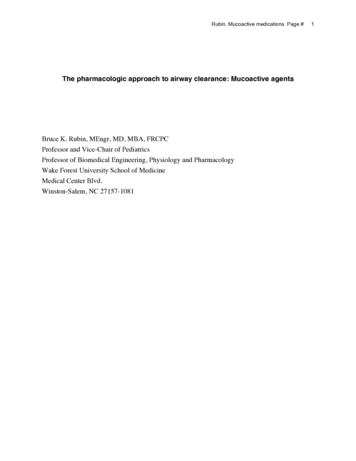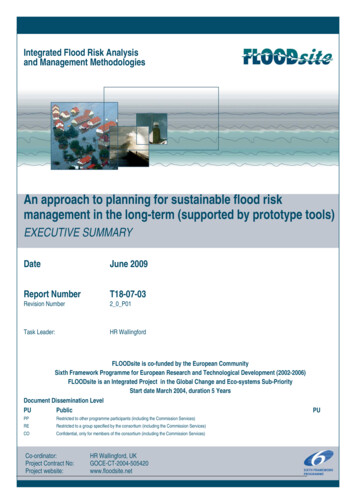
Transcription
Integrated Flood Risk Analysisand Management MethodologiesAn approach to planning for sustainable flood riskmanagement in the long-term (supported by prototype tools)EXECUTIVE SUMMARYDateJune 2009Report NumberT18-07-03Revision Number2 0 P01Task Leader:HR WallingfordFLOODsite is co-funded by the European CommunitySixth Framework Programme for European Research and Technological Development (2002-2006)FLOODsite is an Integrated Project in the Global Change and Eco-systems Sub-PriorityStart date March 2004, duration 5 YearsDocument Dissemination LevelPUPublicPPRestricted to other programme participants (including the Commission Services)RERestricted to a group specified by the consortium (including the Commission Services)COConfidential, only for members of the consortium (including the Commission Services)Co-ordinator:Project Contract No:Project website:HR Wallingford, UKGOCE-CT-2004-505420www.floodsite.netPU
Task 18 Executive Summary long term planningContract No:GOCE-CT-2004-505420DOCUMENT INFORMATIONTitleLead AuthorContributorsDistributionDocument ReferenceExecutive Summary for: An approach to planning for sustainableflood risk management in the long-term (supported by prototypetools)Caroline Mc GaheyPaul Sayers, Marjolein Mens, Jochen Luther, Jochen SchanzePublicT18-07-03DOCUMENT HISTORYDate20/12/0730/4/0715/6/0919/06/09Revision1 0 P11 0 P012 0 P012 0 P01Prepared byC Mc GaheyC Mc GaheyC Mc GaheyPaul SamuelsOrganisationHRWHRWHRWHRWallingfordApproved byPBSPBSPBSNotesInitial Draft – final report due Aug 08Updated DraftFinal DraftFormatting and filenameACKNOWLEDGEMENTThe work described in this publication was supported by the European Community’s Sixth FrameworkProgramme through the grant to the budget of the Integrated Project FLOODsite, Contract GOCE-CT2004-505420.DISCLAIMERThis document reflects only the authors’ views and not those of the European Community. This workmay rely on data from sources external to the members of the FLOODsite project Consortium.Members of the Consortium do not accept liability for loss or damage suffered by any third party as aresult of errors or inaccuracies in such data. The information in this document is provided “as is” andno guarantee or warranty is given that the information is fit for any particular purpose. The userthereof uses the information at its sole risk and neither the European Community nor any member ofthe FLOODsite Consortium is liable for any use that may be made of the information.RELATED DOCUMENTSThe full reports to which this summary relates will be available from the FLOODsite Project Websiteat http://www.floodsite.net/html/search results.asp?documentType as Report Number T18 08 08. Members of the FLOODsite ConsortiumT18 07 03 Task 18 Executive Summary V2 0 P01.doc19 June 2009i
Task 18 Executive Summary long term planningContract No:GOCE-CT-2004-505420CONTENTSDocument InformationDocument HistoryAcknowledgementDisclaimerRelated DocumentsContentsiiiiiiiiEXECUTIVE SUMMARY FOR TASK 181.Scope of the research in Task 18. 12.Principal results . 22.1Literature Review of Decision Support Systems. 22.2Frameworks of Integration . 32.2.1 Conceptual Framework . 32.2.2 Methodological Framework . 52.2.3 Technological Framework. 72.3Prototype Decision Support Tools. 82.3.1 Application of the RASP DS to the Thames Estuary . 82.3.2 Schelde Estuary . 92.3.3 Elbe River Basin . 102.4Overall Findings . 123.Relevance to practice . 133.1Engagement with national organisations and onward dissemination in the UK 133.1.1 MDSF2 - decision support tools. 133.1.2 TE2100 - application to policy and options appraisal . 143.1.3 Northern Rivers Agency - meeting the needs of the Floods Directive. 143.1.4 NADNAC/LTIS/SIP– opportunities for future collaboration . 143.2Engagement with national organisations and onward dissemination in the Netherlands. 143.3Engagement with national organisations and onward dissemination in Germany154.Remaining gaps in knowledge . 155.Acknowledgements . 156.References . 16TablesTable 2.1: Summary of decision support tools reviewed in Task 182FiguresFigure 2.1: Conceptual framework of flood risk management4Figure 2.2: Outline of methodological framework supporting a general DSS tool5Figure 2.3 Spider Diagram adopted for the pilot sites as a common evaluation technique7Figure 2.4: Prototype RASP-DS - Example screen shots as applied to the Thames8Figure 2.5: Schelde Prototype DSS - Comparison of the performance of the ‘do nothing’ risk in 2100with sea level rise plus socio-economic change (left) and sea level rise only (right)9T18 07 03 Task 18 Executive Summary V2 0 P01.doc19 June 2009iii
Task 18 Executive Summary long term planningContract No:GOCE-CT-2004-505420Figure 2.6: Schelde Prototype DSS - Totals for three scenario’s and ‘Current Strategy’ and ‘Stormsurge barrier’, comparison of criteria10Figure 2.7: Elbe web-based Prototype DSS - Start-up page11Figure 2.8: Elbe Tool - View flood risk maps12T18 07 03 Task 18 Executive Summary V2 0 P01.doc19 June 2009iv
Task 18 Executive Summary long term planningContract No:GOCE-CT-2004-505420Executive Summary for Task 181.Scope of the research in Task 18Effective and efficient long-term planning is increasingly recognised as essential to the delivery ofrobust and sustainable Flood Risk Management (FRM) polices in an uncertain future. It enablesdecisions makers to explore strategies, set targets, question the status quo and determine the merits ofinnovative ideas. A key challenge underlying a more strategic approach to planning is the creation ofmeaningful future storylines, in that they reflect the plausible drivers of change and the potentialmanagement response to these. The FLOODsite adopted terminology for these include:-Scenarios for external change i.e. influences that can not be directly controlled in the contextof flood risk management. They include changes to climate change, sea level rise, populationgrowth and macro-economic developments, and to a lesser extent societal resilience, attitudes,preparedness and ecological developments.-Strategic alternatives for flood risk management i.e. the management response includingactions to both reduce the probability of flooding as well as the vulnerability of receptors.Decision support involves providing an evidence-base including information on a range of metrics(damages, casualties, environmental impacts, social equity, uncertainty), as well as a means to usefullyinterpret this information to support the choice of the best course of action. Thus, Task 18 provides aframework for long-term flood risk management planning, building on the knowledge in FLOODsiteThemes 1 and 2 (e.g. De Bruijn et al, 2008), and enacts elements of these through prototype DecisionSupport System (DSS) tools. The primary objectives are:-To provide a conceptual framework for long term FRM planning that enables information onflood risks and management options to be integrated in support of identifying preferred futuremanagement strategies.-To enact the conceptual framework within a prototype decision support tool that enables thedecision maker to integrate multiple and complex relationships between natural hazards, socialand economic vulnerability, the impact of measures and instruments for risk mitigation insupport of FRM planning in the long term.During the project, the need for a conceptual, methodological and technological framework wasidentified - and Task 18 provides these three levels of integration. The frameworks follow the widelyaccepted Source-Pathway-Receptor-Consequence model which underpins the FLOODsite work(Sayers et al, 2002). Emphasis is placed on the decision support evaluation criteria (e.g. sustainability,robustness, adaptability) and techniques (e.g. Benefit-Cost Analysis, Multi-Criteria Analysis,Infractions etc.). Elements of these frameworks are enacted within three prototype decision supporttools, each developed in the context of one of the pilot sites: the Thames Estuary, the Schelde Estuaryand the Elbe River Basin.The Task 18 work provides the vital ingredients for how to go about any long-term strategic study andwould be an essential component in meeting the aims of the European Floods Directive. Specifically,it would support the development of Flood Risk Management Plans which are required for eachmember state by 22 December 2015.The full Task 18 details are available in Mc Gahey et al, 2009 and the main findings are summarisedbelow.T18 07 03 Task 18 Executive Summary V2 0 P01.doc19 June 20091
Task 18 Executive Summary long term planningContract No:GOCE-CT-2004-5054202.Principal results2.1Literature Review of Decision Support SystemsDecision Support Systems (DSS) have been developed ad infinitum. Many have been useful andmany more have been useless. The most pertinent questions that distinguish useful from useless havebeen distilled from the Task 18 review of existing DSS tools (Schanze et al, 2007). The reviewcovered 19 tools (Table 2.1), predominantly from Germany, the Netherlands and the UK, consisting oflong-term FRM tools as well as operational systems not specifically designed for long-term analyses,but considered useful additional sources of information. The review criteria included:-Contents such as representation of the flood risk system, management measures, spatial andtemporal scales, output metrics etc.Data and methodsPresentation including target users and visualisationTechnology e.g. software architecture;Other e.g. user/software support, application strengths and weaknessesThe most significant of the findings include the need for:-Clarity of decision being supported (not aim to solve too many things);Understanding the target user (user engagement throughout);Methods should reflect the policy context i.e. currently risk-based methods;Uncertainty should be explicitly recognised and appropriately disaggregated by source;Representation of output metrics should be clear whilst reflecting the complexity of theunderlying analysis e.g. high level aggregation of data into useable evidence;Tools should be appropriately modular and flexible, limiting dependence on proprietarysoftware where possible and independent of data source (e.g. user entered, external models);Ongoing support, training, maintenance releases etc. are critical to user uptake.It is worth bearing in mind that aside from their FRM decisions, decision makers also need to decidewhich DSS tool to use. DSSs may be an effective means of giving support provided they are broadlydeveloped in accordance with these findings. A successful example is the Environment Agency (EA)of England and Wale’s Modelling and Decision Support Framework (MDSF), which has been widelyapplied in support of Catchment Flood Management Plans and Shoreline Management Plans. Thissuccess is largely attributed to the flexible nature of the software which aggregates results fromexternal models, reducing the complexity of use, and the ongoing user support and training. TheMDSF2 is currently being developed (Mc Gahey & Sayers, 2009) and the main drivers of this are themove to a more risk-based approach and the EA’s desire for software which is as platformindependent as possible - corroborating some of the findings of the review (Surendran et al, 2008).Table 2.1: Summary of decision support tools reviewed in Task 18DSS-AcronymPlanning KitIRMA-SpongeDSS Large RiversIVB-DOSSTORM RhineMDSFEUROTASFlood RangerFull NameIntegrale Verkenning Benedenrivieren – Discussie Ondersteunend Systeem (IntegratedExploration of the Lower Rivers – Discussion Supporting System)Simulation Tool for River Management of the RhineModelling and Decision Support FrameworkEuropean River Flood Occurrence and Total Risk Assessment SystemT18 07 03 Task 18 Executive Summary V2 0 P01.doc19 June 20092
Task 18 Executive Summary long term planningContract RBM-DSSElbe-DSSINFORM 2.0/.DSSRISKFLIWASFLUMAGIS2.2Decision Support for Integrated Coastal Zone ManagementNational-scale Flood Risk AssessmentPerformance-based Asset Management SystemHochwasserinformationssystem zur Gefahrenabwehr (Flood Information System forHazard Defence)Decision Support System for the Havel riverWerra River Basin Management DSSDecision Support System for the Elbe riverIntegrated Floodplain Response ModelRisikoinformationssystem Küste (Risk Information System Coast)Flood Information and Warning SystemFlusseinzugsgebietsmanagement mit GIS (GIS-based River Basin Management)Frameworks of IntegrationSuccessful support to long term planning requires the following:-A common Conceptual Framework which seeks to understand and formalise the full range ofissues that stakeholders may pose.-A supporting Methodological Framework which is a translation of the conceptual frameworkinto an analysis process containing tangible algorithms, methods and model interactions.-An extendable and adaptable Technological Framework which considers the software andassociated development protocols to be used to enact the methodology framework andcrucially display the output risk metrics.2.2.1 Conceptual FrameworkThe conceptual framework is a high-level view of the long-term planning process, which seeks tounderstand the full range of questions that different stakeholders may pose to support their long-termplanning needs. This includes:-Development of a knowledge base on flood risk issues;An overview of the relationship between flood risk management and the development ofnatural and societal systems (landscapes, social acceptance, local economy);A review of the organisational structures and institutions across Europe together with theregulatory, economic and socio-cultural conditions in which they operate;An overview of societal needs and long-term perception of risks;An overview of available strategic options (including mixed resistance and resilience basedstrategies).The risk concept is only one component of good flood management which demands integration acrosssectorial interests as well as spatial and temporal domains. Thus, an important notion in theconceptual framework is the move towards Integrated Flood Risk Management (IFRM). This is acomprehensive and continuous process of analysis, assessment and action where the FRM process isembedded within the wider societal planning processes and broader water management activities. Assuch, IFRM can be seen as distinct from the primarily reactive approaches that have oftencharacterised traditional flood defence based paradigms and the often sectorial context of current FRMapproaches (for example focusing on specific sources of flooding and/or mitigation options). To makeprogress towards IFRM, the current approaches to risk analysis, assessment and management need tobe challenged and refined, including:-Risk analysis - including hazard definition; whole system model integration; softwareintegration; the identification and handling of uncertainty.T18 07 03 Task 18 Executive Summary V2 0 P01.doc19 June 20093
Task 18 Executive Summary long term planningContract No:GOCE-CT-2004-505420-Risk assessment - including normative perspectives; multi-criteria assessment; acceptabilityand tolerability; disciplinary integration; the use of scenarios and strategic alternatives;structured approaches to the assessment of sustainability through consideration of decisionrobustness and flexibility.-Risk management - including the implementation of a portfolio of measures from pre-event,during event and post event actions in association with supporting activities of monitoring andresourcing, and embedded within wider societal plans.The Figure 2.1 provides an overview of the conceptual framework and the core components: riskanalysis, risk assessment and risk measures.Decision making and development process of actors with their strategiesRisk AnalysisRisk AssessmentRisk MeasuresRisk ation„Cost“of damagesor measuresDeterminationof flood risk„Benefits“of useWeighingflood riskPrefloodFloodeventPost-floodStrategic alternativesfor flood risk mitigationFigure 2.1: Conceptual framework of flood risk managementA number of examples are emerging where IFRM is starting to influence practice. These include theintegration of international policy (e.g. recognizing the importance of flood risk and flood riskmanagement plans through the Floods Directive), the increasingly integrated national policy guidance(e.g. Making Space for Water in the UK) and the use of hierarchical planning processes – fromnational scale (e.g. Foresight Future Flooding in the UK) through to regional (e.g. Schelde and Rhine,Netherlands, and the Thames, UK) and onto local management planning (e.g. German Bight) to bridgethe gap between policy and action.The challenge of achieving IFRM in practice can not be underestimated. It will depend uponimproved and more efficient tools and techniques (providing improved functionality to explore riskand a richer, more useful and useable evidence on risk). It will also crucially depend upon the commondesire across all stakeholders (researchers, practitioners and policy makers) to achieve better. Themethodological and technological frameworks described below are a first and significant step in thisdirection.T18 07 03 Task 18 Executive Summary V2 0 P01.doc19 June 20094
Task 18 Executive Summary long term planningContract No:GOCE-CT-2004-5054202.2.2 Methodological FrameworkThe methodological framework is a translation of the conceptual framework into tangible algorithms,methods and component interactions. Implicit within this is the need to develop future climatic andsocio-economic scenarios and to characterise the management response through time (strategicalternatives) and hence the evaluation of these responses in an uncertain future. Uncertainty isaddressed in terms of that arising from methods, models and data, as well as the more grossuncertainty associated with the future. Emphasis is also placed on how best to present the information(including uncertainty) to form a useful evidence-base for decision-makers. Figure 1 shows the highlevel components of the methodological framework. The modules include:Pathway ModuleReceptor ModuleCost of interventionsDSS input databasesExternal Driver ModuleUncertainty throughout processSource ModuleManagement Response ModuleSource Module: Traditionally the source module is used to derive the source terms which may be theprecipitation, the catchment run-off, the inflows to the river system or the in-river or coastal waterlevels. The source terms are defined here as all elements upstream of the first managementintervention.Consequence ModuleRisk ModuleDecision Support ModuleInformation to decision makers e.g. plots, tables, animations etc.Figure 2.2: Outline of methodological framework supporting a general DSS toolPathway Module: This is used to describe the pathways including the important flood characteristicssuch as inundation depth, duration and velocity. The pathway module starts from the firstmanagement intervention and characterises the path through to the receptor terms, taking account ofall upstream probabilities (e.g. precipitation, event, defence performance), to provide the probabilisticdepth and velocity grid for the floodplain.Receptor Module: This is where the receptor information is collated i.e. the receptor exposure basedon location, number and characteristics e.g. residential property, infrastructure, designated habitats.Consequence Module: This includes receptor damage and vulnerability information. More compleximpacts such as social equity, environmental degradation, habitat reduction etc. are includedT18 07 03 Task 18 Executive Summary V2 0 P01.doc19 June 20095
Task 18 Executive Summary long term planningContract No:GOCE-CT-2004-505420qualitatively as the methods for quantifying these in terms of economic damage are still at an theembryonic stage.Risk Module: This integrates the outputs from the path-way consequences modules to provide thebasic risk metrics. The outputs are expressed quantitatively (e.g. monetary value, expected economicdamage), by category (e.g. high, medium, low) or descriptively.External Driver Module: This is used to define the changes in the flood risk system due toautonomous events. These are implemented at different stages of the analysis as they affect differentterms, for example, changes to the source may include altered loadings due to climate change.Management Response Module: This allows for structural and non-structural intervention options tobe de-scribed in simple terms reflecting physical change (e.g. a dyke crest level), or likely reduction ineither receptor exposure or vulnerability. This module also includes option costs.Decision Support Module: This integrates results from all previous modules into performanceindicators for pre-specified criteria (e.g. robustness, adaptability) which can then be used in theevaluation of the preferred strategic alternative. These criteria will be used in the context of differentanalyses e.g. present value, risk reduction, benefit-cost to provide useful and credible guidance todecision makers.A distinction is drawn between items which the flood risk manager has no influence over (Scenariocomponents) in the context of FRM and those which he has direct influence over (StrategicAlternatives components).In the development of the methodological framework, emphasis is placed on the long-term planningdecision support criteria (Decision Support Module), which include:-Sustainability: the ability of a strategic alternative to meet the needs of the present withoutcompromising the ability of future generations to meet their own needs. This is typicallylinked to robustness and adaptability as well as social, ecological and economicconsiderations.-Robustness: the ability of a given strategic alternative to perform well in the context of allpossible future scenarios.-Adaptability: the ability of a given strategic alternative to adapt following monitoring andobservation of what actually does happens (e.g. heavy investments where the need is notrealised.-Uncertainty: recognition and representation of uncertainty due to date, methods and models aswell as the gross uncertainty associated with future change.The evaluation techniques (e.g. multi-criteria analysis, benefit cost analysis, incremental benefit costanalysis, pair-wise comparisons, Delphi technique, infractions etc) are also a focus in the study. Theframework is not prescriptive about which evaluations techniques to use, and encourages the use ofmore than one in ranking options. However, for the pilot site applications a common technique wasadopted as one of the evaluation techniques. This was based on a Spider Diagram (Figure 2.3) whereeach axis represents a performance measure, for example, robustness, adaptability, affordability, socialjustice and ecology. The output performance is expressed as a probability distribution on each axis –to indicate the associated uncertainty – and the user defined tolerable and desirable limits are thenindicated on each axis. This provides a visual impression of the overall performance and uncertaintyand it is quick to tally the number of axes where the performance is undesirable, tolerable anddesirable.T18 07 03 Task 18 Executive Summary V2 0 P01.doc19 June 20096
Task 18 Executive Summary long term planningContract No:GOCE-CT-2004-505420Adaptability10Social Justice100 esilienceTolerable7Desirable10EcologyFigure 2.3 Spider Diagram adopted for the pilot sites as a common evaluation technique2.2.3 Technological FrameworkThe technological framework supports the development of computational tools to enact the methodsand algorithms through specific applications, which may involve development of software modules orcomputer-based tools to execute the methods and display the outputs. The technological framework isnot intended to prescribe a particular environment, but rather to establish a process for supporting theimplementation of the methodological framework as appropriate to a site-specific application. Itconsiders:-the users and their requirements;the methods;the system architecture and related software/hardware requirements; andthe future path.Once the technological framework has been established, the outcomes should enable rapiddevelopment of the DSS functional specification ready for software development. By way ofexample, the “system architecture” component covers:-software application e.g. web-based, local personal computer, distributed, otherdependence of tool (or select embedded functionality) on proprietary softwarelinking with external models, model couplingdegree of modularity/flexibility e.g. use of user input or default embedded modelmeans of importing data or pre-populating databasemeans of editing data to create casescase management e.g. selecting and working with casesmetadatadatabase type and structureT18 07 03 Task 18 Executive Summary V2 0 P01.doc19 June 20097
Task 18 Executive Summary long term planningContract No:GOCE-CT-2004-505420-2.3workflows i.e. how the central processing unit performs internally and accesses addresses inmemoryprogramming languagerun-timenature and implications for Graphical Use Interface of required outputs e.g. tables, graphs,maps, animations etc.Prototype Decision Support ToolsThe decision support frameworks were enacted in the context of three sites: the Thames Estuary, theSchelde Estuary and the Elbe River Catchment. Mc Gahey et al (2009) provide a thoroughcomparison of the commonalities and differences between these tools (Table 2.8) and dedicate achapter to each tool. Here, a brief summary and example screen shot is provided for each.2.3.1 Application of the RASP DS to the Thames EstuaryThe Risk Assessment for Strategic Planning Decision Support tool (RASP DS) was developed andapplied to the Thames Estuary. The tool is geared towards use by consultants and consists of on-linecalculations to process hydraulic model outputs (in-river and coastal water levels) to evaluate risk.Key elements in the risk calculation include an embedded rapid flood spreading model, an ability totake defence performance into account; attribution of risk to individual defences and consideration ofthe number of people exposed to hazard over the appraisal period. The evaluation techniques includepresent value calculation; a move to a more continuous robustness analysis through a more continuousrepresentation of the future climate and socio-economic space; infraction analysis; benefit costanalysis and incremental benefit cost analysis. Figure 2.4 provides an example screen shot from theRASP DS. Interactive viewing is available on the FLOODsite web pages, see: www.floodsite.net.Figure 2.4: Prototype RASP-DS - Example screen shots as applied to the ThamesT18 07 03 Task 18 Executive Summary V2 0 P01.doc19 June 20098
Task 18 Executive Summary long term planningContract No:GOCE-CT-2004-5054202.3.2 Schelde EstuaryThe Schelde DSS is geared towards high-level users such as members of parliament or planners andthus it consists of a clear intuitive user-interface that draws on a database of previously generatedresults. There are few on-line calculations and the emphasis of the development is on ease of use andthe presentation of outputs (Figure 2.5). The tool provides in-year and present day risk, cost, riskreduction, benefit cast and sensitivity to uncertainties. It places emphasis on visual presentation ofresults e.g. maps, graphs, spider diagrams and overlays (Figure 2.6). The Schelde DSS tool is a standalone tool and may be freely downloaded from the FLOODsite web pages, see: www.floodsite.net.Figure 2.5: Schelde Prototype DSS - Comparison of the performance of the ‘do nothing’ risk in 2100with sea level rise plus socio-economic change (left) and sea level rise only (right)T18 07 03 Task 18 Executive Summary V2 0 P01.doc19 June 20099
Task 18 Executive Summary long term planningContract No:GOCE-CT-2004-505420Figure 2.6: Schelde Prototype DSS - Totals for three scenario’s and ‘Current Strategy’ and ‘Stormsurge barrier’, comparison of criteria2.3.3 Elbe River BasinThe Elbe River Basin tool is aimed at high-level users (e.g. ministries) as well as the general public. Itis developed on a web platform (Figure 2.7), which provides a front-end to a series of pre-cookedresults, enabling users to explore questions and view results in
2.1 Literature Review of Decision Support Systems Decision Support Systems (DSS) have been developed ad infinitum. Many have been useful and many more have been useless. The most pertinent questions that distinguish useful from useless have been distilled from the Task 18 review of existing
